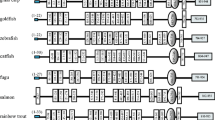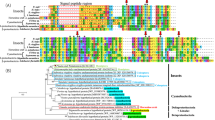Abstract
Toll-like receptors are sentinels of innate immune system, which recognise pathogen-associated molecular patterns, and subsequently activate production of antimicrobial peptides to contain the infection. In the present study, we cloned and characterised a Toll gene from Scylla serrata (SsToll) encoding 1005 amino acids with typical Toll-like receptor domain topology. Phylogenetic analysis revealed that it belongs to insect-type invertebrate Toll family showing 100 % identity with Scylla paramamosain (SpToll). The expression pattern of mRNA in different tissues indicated that SsToll is constitutively expressed in all the tissues examined, with varying expression levels. The expression was also detected in all the life-stages (egg, zoea stages 1–5, megalopa and crab instar) with the highest level observed in zoea 2. In-vitro studies using crab haemocyte culture demonstrated that SsToll transcripts are distinctly modulated in response to ligands such as peptidoglycan and lipopolysaccharide at all time-points. A significant change in SsToll expression was also noticed in haemocytes exposed to poly I:C (3–9 h). On the contrary, the transcription level of SsToll in response to white spot syndrome virus (WSSV) challenge was noticeably different. The change in expression in vitro was not significant at early time-points until 3 h; the transcripts showed a significant up-regulation commencing from 6 h, but not beyond 12 h. However, in vivo expression was unaffected at early time-points of WSSV challenge (until 12 h) and a gradual up-regulation was detected at 24 h. In-vivo challenge with Vibrio parahaemolyticus resulted in delayed up-regulation of the gene. The results obtained in the present study suggest that SsToll might be involved in the innate immunity of mud crab.










Similar content being viewed by others
References
Magnadottir B (2006) Innate immunity of fish (overview). Fish Shellfish Immunol 20:137–151
Aoki T, Takano T, Santos MD, Kondo H, Hirono I (2008) Molecular innate immunity in Teleost fish: review and future perspectives. 5th World Fish Congress 263–276
Akira S, Uematsu S, Takeuchi O (2006) Pathogen recognition and innate immunity. Cell 124:783–801
Medzhitov R, Janeway CA Jr (1997) Innate immunity: the virtues of a nonclonal system of recognition. Cell 91:295–298
Franchi L, Eigenbrod T, Munoz-Planillo R, Nunez G (2009) The inflammasome: a caspase-1-activation platform that regulates immune responses and disease pathogenesis. Nat Immunol 10:241–247
Chen X, Zhang M, Zhu X, Deng Q, Liu H, Larmonier N et al (2009) Engagement of Toll-like receptor 2 on CD4(+) T cells facilitates local immune responses in patients with tuberculous pleurisy. J Infect Dis 200:399–408
Akira S, Takeda K (2004) Toll-like receptor signalling. Nat Rev Immunol 4:499–511
Rebl A, Goldammer T, Seyfert H (2010) Toll-like receptor signalling in bony fish. Vet Immunol Immunopath 134(3–4):139–150
Arts JA, Cornelissen FH, Cijsouw T, Hermsen T, Savelkoul HF, Stet RJ (2007) Molecular cloning and expression of a Toll receptor in the giant tiger shrimp, Penaeus monodon. Fish Shellfish Immunol 23:504–513
Mekata T, Kono T, Yoshida T, Sakai M, Itami T (2008) Identification of cDNA encoding Toll receptor, MjToll gene from kuruma shrimp, Marsupenaeus japonicus. Fish Shellfish Immunol 24:122–133
Yang LS, Yin ZX, Liao JX, Huang XD, Guo CJ, Weng SP et al (2007) A Toll receptor in shrimp. Mol Immunol 44:1999–2008
Yang C, Zhang J, Li F, Ma H, Zhang Q, Priya TAJ et al (2008) A Toll receptor from Chinese shrimp Fenneropenaeus chinensis is responsive to Vibrio anguillarum infection. Fish Shellfish Immunol 24:564–574
Wang PH, Liang JP, Gu ZH, Wan DH, Weng SP, Yu XQ et al (2012) Molecular cloning, characterization and expression analysis of two novel Tolls (LvToll2 and LvToll3) and three putative Spatzle-like Toll ligands (LvSpz1–3) from Litopenaeus vannamei. Dev Comp Immunol 36:359–371
Lin Z, Qiao J, Zhang Y, Guo L, Huang H, Yan F, Li Y, Wang X (2012) Cloning and characterisation of the SpToll gene from green mud crab, Scylla paramamosain. Dev Comp Immunol 37:164–175
Yu AQ, Jin XK, Guo XN, Li S, Wu MH, Li WW, Wang Q (2013) Two novel Toll genes (EsToll1 and EsToll2) from Eriocheir sinensis are differentially induced by lipopolysaccharide, peptidoglycan and zymosan. Fish Shellfish Immunol 35:1282–1292
Lemaitre B, Nicolas E, Michaut L, Reichhart JM, Hoffmann JA (2003) The dorsoventral regulatory gene cassette spatzle/Toll/cactus controls the potent antifungal response in Drosophila adults. Cell 86:973–983
Rutschmann S, Kilinc A, Ferrandon D (2002) Cutting edge: the Toll pathway is required for resistance to Gram-positive bacterial infections in Drosophila. J Immunol 168:1542–1546
De Gregorio E, Spellman PT, Tzou P, Rubin GM, Lemaitre B (2002) The Toll and Imd pathways are the major regulators of the immune response in Drosophila. EMBO J 21:2568–2579
Lemaitre B, Hoffmann J (2007) The host defense of Drosophila melanogaster. Annu Rev Immunol 25:697–743
Valanne S, Wang JH, Ramet M (2011) The Drosophila Toll signalling pathway. J Immunol 186:649–656
Zambon RA, Nandakumar M, Vakharia VN, Wu LP (2005) The Toll pathway is important for an antiviral response in Drosophila. Proc Natl Acad Sci USA 102:7257–7262
Kathirvel M (1993) Mud crab. Handbook on aqua farming of shrimps, lobsters and crabs. MPEDA Publication, Cochin, p 72
Kumar B, Deepika A, Makesh M, Purushothaman CS, Rajendran KV (2012) Production and characterization of monoclonal antibodies to the hemocytes of mud crab, Scylla serrata. J Invertebr Pathol 111(1):86–89
Rajendran KV, Vijayan KK, Santiago TC, Krol RM (1999) Experimental host range and histopathology of white spot syndrome virus (WSSV) infection in shrimp, prawns, crabs and lobsters from India. J Fish Dis 22:183–191
Deepika A, Makesh M, Rajendran KV (2014) Development of primary cell cultures from mud crab, Scylla serrata and their potential as an in vitro model for replication of white spot syndrome virus. Vitro Cell Dev Biol Anim 50(5):406–416
Pfaffl MW (2001) A new mathematical model for relative quantification in realtime RT-PCR. Nucleic Acids Res 29:2002–2007
Zhang Y, Söderhäll I, Söderhäll K, Jiravanichpaisal P (2010) Expression of immune-related genes in one phase of embryonic development of freshwater crayfish, Pacifastacus leniusculus. Fish Shellfish Immunol 28:649–653
Li F, Xiang J (2013) Signaling pathways regulating innate immune responses in shrimp. Fish Shellfish Immunol 34:973–980
Bourgeois LB, Bosworth BG, Peterson BC (2008) Differences in mortality, growth, lysozyme, and Toll-like receptor gene expression among genetic groups of catfish exposed to virulent Edwardsiella ictaluri. Fish Shellfish Immunol 24:82–89
Muthukuru M, Jotwani R, Cutler CW (2005) Oral mucosal endotoxin tolerance induction in chronic periodontitis. Infect Immun 73:687–694
Ortega-Cava CF, Ishihara S, Rumi MAK, Aziz MM, Kazumori H, Yuki T et al (2006) Epithelial toll-like receptor 5 is constitutively localized in the mouse cecum and exhibits distinctive down-regulation during experimental colitis. Clin Vacc Immunol 13:132–138
Yao C, Kong P, Wang Z, PJi P, Cai M, Liu X, Han X (2008) Cloning and expression analysis of two alternative splicing toll-like receptor 9 isoforms A and B in large yellow croaker, Pseudosciaena crocea. Fish Shellfish Immunol 25:648–656
Basu M, Swain B, Maiti NK, Routray P, Samanta M (2012) Inductive expression of toll-like receptor 5 (TLR5) and associated downstream signaling molecules following ligand exposure and bacterial infection in the Indian major carp, mrigal (Cirrhinus mrigala). Fish Shellfish Immunol 32:121–131
Samanta M, Swain B, Basu M, Panda P, Mohapatra GB, Sahoo BR, Maiti NK (2012) Molecular characterization of toll-like receptor 2 (TLR2), analysis of its inductive expression and associated down-stream signaling molecules following ligands exposure and bacterial infection in the Indian major carp, rohu (Labeo rohita). Fish Shellfish Immunol 32:411–425
Wang PH, Yang LS, Gu ZH, Weng SP, Yu XQ, He JG (2013) Nucleic acid-induced antiviral immunity in shrimp. Antivral Res 99:270–280
Acknowledgments
The authors are thankful to Dr. W.S. Lakra, Director, CIFE, for providing necessary facilities.
Author information
Authors and Affiliations
Corresponding author
Rights and permissions
About this article
Cite this article
Vidya, R., Paria, A., Deepika, A. et al. Toll-like receptor of mud crab, Scylla serrata: molecular characterisation, ontogeny and functional expression analysis following ligand exposure, and bacterial and viral infections. Mol Biol Rep 41, 6865–6877 (2014). https://doi.org/10.1007/s11033-014-3572-0
Received:
Accepted:
Published:
Issue Date:
DOI: https://doi.org/10.1007/s11033-014-3572-0




